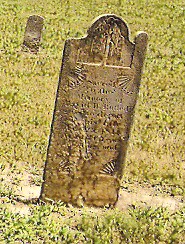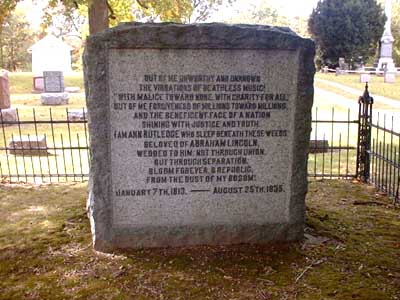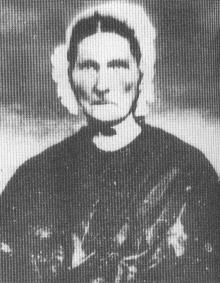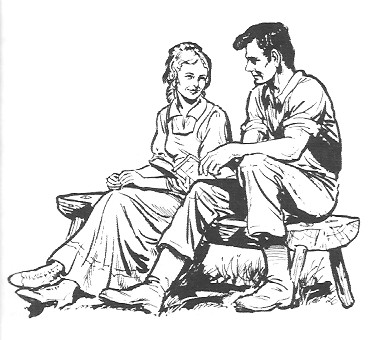Ann Rutledge |
The love affair between the youthful Abraham Lincoln and the fair maiden, Ann Rutledge, is not 100% proven.* For over 150 years historical opinion has vacillated on the veracity of this relationship. However, if the actual New Salem residents are to be believed, the validity of the affair was very real.
|
|
|
Ann Mayes Rutledge was born on January 7, 1813, near Henderson, Kentucky. She was the third of ten children born to Mary and James Rutledge. In 1829, along with John M. Cameron, James Rutledge founded New Salem, Illinois. There they built a dam; alongside the dam both a sawmill and gristmill were constructed. As business increased, Rutledge and Camron decided to lay out a town and sell lots. Over the next few years New Salem became a fairly typical pioneer town.
Soon James Rutledge converted his home into a tavern and built an addition for guests. One can imagine Ann helping her mother with the cooking, doing household chores, and serving the guests. She was an excellent seamstress. Eventually, Ann took over the management of the tavern. Also, she was the only girl to attend Mentor Graham's New Salem school.
The photograph to the right depicts the cover of the actual grammar text used by Ann Rutledge and Abraham Lincoln. Ann's signature is at the top. The book is in the Library of Congress.**
Eyewitnesses described Ann as intelligent, pretty and friendly. Her cousin, James McGrady Rutledge, said, "She was a beautiful girl and as bright as she was beautiful." She had auburn hair, blue eyes, stood five feet three inches, and weighed about 120 pounds. It would seem her character was positively noted throughout the area. She was described as sweet and angelic; apparently she was loved by all who knew her. A "bigger than life" person almost arises in one's imagination.
|
|
|
A new resident in town, Abraham Lincoln, boarded for a while at the tavern. However, Ann became engaged to a man named John MacNamar who had come west from New York. MacNamar formed a partnership with Samuel Hill and started a store. With the profits from this enterprise, he was able to acquire considerable property. MacNamar, who had assumed the name "McNeil" for dubious reasons, told Ann he needed to return to his parents in the east but would come back to New Salem to marry her. In 1832 MacNamar left on his trip.
Time passed... and MacNamar didn't return. What happened next has been the subject of profound historical speculation, conjecture, and inference.
After Lincoln's death in 1865, William Herndon interviewed former New Salem residents including surviving members of the Rutledge family. Although the details these people remembered varied some in particulars, it seems clear a definite relationship between Ann and Abraham developed. When Mary Owens visited New Salem in 1833 Abraham took notice, but it seems his deeper feelings were for Ann. Abraham visited her often, and it is possible they became unofficially engaged with the intent to marry after Lincoln obtained his law degree (which he was studying for while living in New Salem).
In the summer of 1835 Ann became ill with what may have been typhoid fever. Her condition worsened to the point where death beckoned. Ann called for Abraham, and he made a private, final visit to the dying girl.
"I can never forget how sad and broken-hearted Lincoln looked when he came out of the room from the last interview with Annie. No one knows what was said at that meeting, for they were alone together." - Quote from Ann's sister, Nancy.
"A better man never lived." - Quote about Abraham Lincoln by Ann's brother, John.
|
|
Shortly thereafter, on August 25, 1835, Ann Rutledge passed away at the age of 22. Reports of Lincoln's reaction vary. Many thought he became terribly depressed. A few of the locals thought he became suicidal. After all, this had been his very first serious romance.
In 1865 Mentor Graham (right), the former New Salem schoolmaster, said of Ann, "I know Miss Ann Rutledge took sick while going to school. Lincoln and she both were studying at my house. Miss Rutledge died about 1834. She was about 20 years old, blue eyes, large and expressive, fair complexion - sandy or light auburn hair not flaxen. About 5 feet 4 face rather round - outlines beautiful - nervous element predominated. She had good teeth - mouth well made - beautiful. Nervous chin.
Weight about 120-130. Beautiful and ingenious - amiable - kind - exceptionally good scholar in all the common branches including grammar. She was beloved of everybody and she loved everybody. Lincoln and she were engaged - Lincoln told me so - and she intimated to me the same. He - Lincoln - told me he felt like committing suicide after her death but I know him of God's higher purpose. He told me he thought so too - somehow - couldn't tell how. He said my remarks and others' had often done him good." |
|
|
|
Ann was buried at the Concord graveyard which was a country burying-ground about seven miles northwest of New Salem. Lincoln visited her gravesite frequently. Many years later, Ann's remains were moved. Some people in nearby Petersburg felt her grave would help put the town "on the map." Her coffin was disinterred on May 15, 1890. The next morning it was re-buried in Petersburg's Oakland Cemetery. The announcement was then made that Lincoln's first love was now interred in Petersburg.
For details on the "reburial" please see chapter four (pp. 51-59) in Edward Steers' Lincoln Legends: Myths, Hoaxes, and Confabulations Associated With Our Greatest President (Lexington, University Press of Kentucky, 2007).
Below are two contemporary photographs from the Old Concord Cemetery. The cemetery is reached by driving across a farm field. The photo to the left depicts the marker showing the original burial place for Ann. Ann's brother, David Rutledge, is buried to the right of her marker. Many thanks to Joe Di Cola for contributing the photos to this website! Below Joe's photos is a picture of Ann's gravestone at Petersburg's Oakland Cemetery.
 

Nowadays, signs in the area of Petersburg point the way to Ann's grave. The Old Concord Cemetery is located four miles to the north. Roughly 200 people are buried there. Many of them knew Abraham and Ann personally; they knew the truthfulness of the courtship.
Sadly, no photographs of Ann exist. The first American daguerreotypes were made in 1839, four years after her untimely death. For an in-depth look at Ann's life, try The Shadows Rise: Abraham Lincoln and the Ann Rutledge Legend by John Evangelist Walsh (Urbana, University of Illinois Press, 1993). Except where otherwise noted, the photographs on this page came from Mr. Walsh's excellent book.
In his biography titled Lincoln, David Herbert Donald relates this story: After his election as president, an old friend, Isaac Cogdal, visited Lincoln. Cogdal, a quarryman and former New Salem resident, asked the president-elect if he had fallen in love with Ann. According to Cogdal, Lincoln replied, "It is true - true indeed I did. I loved the woman dearly and soundly: she was a handsome girl - would have made a good loving wife... I did honestly and truly love the girl and think often - often of her now."
Edgar Lee Masters memorialized the Ann Rutledge legend in an epitaph. His words are engraved on her tombstone at Oakland Cemetery:
"Out of me unworthy and unknown
The vibrations of deathless music!
'With malice toward none, with charity for all'.
Out of me the forgiveness of millions toward millions,
And the beneficent face of a nation
Shining with justice and truth.
I am Ann Rutledge who sleep beneath these weeds,
Beloved of Abraham Lincoln,
Wedded to him, not through union,
But through separation.
Bloom forever, O Republic,
From the dust of my bosom!"
|
|
|
* Mary Todd Lincoln, as well as some professional historians, never believed one word of it. The pendulum swung back and forth on the Ann/Abraham relationship during the 20th century. After a period in which the love affair was at least partially discarded, recent published material is again generally leaning in the direction of the truthfulness of the relationship.
**This original copy of Kirkham's Grammar remained in the Rutledge family until 1922 when it was loaned to the Decatur (Illinois) Public Library. Eventually, the book became an outright gift, and the Decatur Library gave it to the Library of Congress.
Mentor Graham's statement about Ann came from p. 253 of Mentor Graham: The Man Who Taught Lincoln by Kunigunde Duncan and D. F. Nickols. For those wishing to read a recent book which strongly argues that the preponderance of evidence favors the Ann Rutledge/Abraham Lincoln romance, please see Lincoln Before Washington: New Perspectives on the Illinois Years by Douglas L. Wilson (Urbana, University of Illinois Press, 1997).
The idea to move Ann's remains was the idea of a gentleman named Samuel Montgomery. Mr. Montgomery was a Petersburg civic leader, undertaker, furniture maker, and secretary of Petersburg's burial ground (Oakland Cemetery). He passed away on March 9, 1928, and his obituary was printed in The Petersburg Democrat. John Montgomery, great grandson of Samuel Montgomery, was kind enough to send me a copy of the obituary. I am including the paragraph in the obituary which dealt with the disinterment of Ann Rutledge's remains:
"To a casual acquaintance, Mr. Montgomery appeared a practical, methodical, conservative business man, but, on more than one occasion, a deep, underlying vein of sentiment expressed itself with a generous ardor that had far-reaching results. It was in May, 1890, that, pursuing his vocation, he discovered, beneath high tangled weeds in a neglected corner of the old Rutledge burying ground, the sunken grave of Ann Rutledge. He took a picture of it but was much disturbed about so poor a resting place for a friend of Abraham Lincoln. The sentiment took much control of his thoughts that, securing the consent of her relatives, he chose, at his own expense, the lovely spot on Oakland’s hill, and, in the presence of her cousins, disinterred the remains and removed them to the new-made grave. He desired that the marker should come, if possible, from the vicinity of New Salem, the scene of the romance, and after diligent search of the banks of Rock Creek, he found the small boulder which rests at the foot of the grave, and his friend, Charles Richter, engraved the name that marks it. Let it recall the generous spirit of Samuel Montgomery that drew repeatedly on time, strength and purse when there was wrong to right or a burden which he could help bear."
|
|
Thank you to John Montgomery for the above information!
NOTE: The actual 8th line of Masters' verse reads "Beloved in life of Abraham Lincoln." The reason the words "in life" were omitted on Ann's headstone is unclear.
The image of Ann and Abraham at the top of the page came from p. 135 of Lincoln Legends: Myths, Hoaxes, and Confabulations Associated With Our Greatest President by Edward Steers, Jr. (Lexington, University Press of Kentucky, 2007). Dr. Steers' source was a postcard, ca. 1950.
|
|

Photograph of Ann's mother, Mary Ann Rutledge, taken c.1870 when she was in her 80's. |
|







